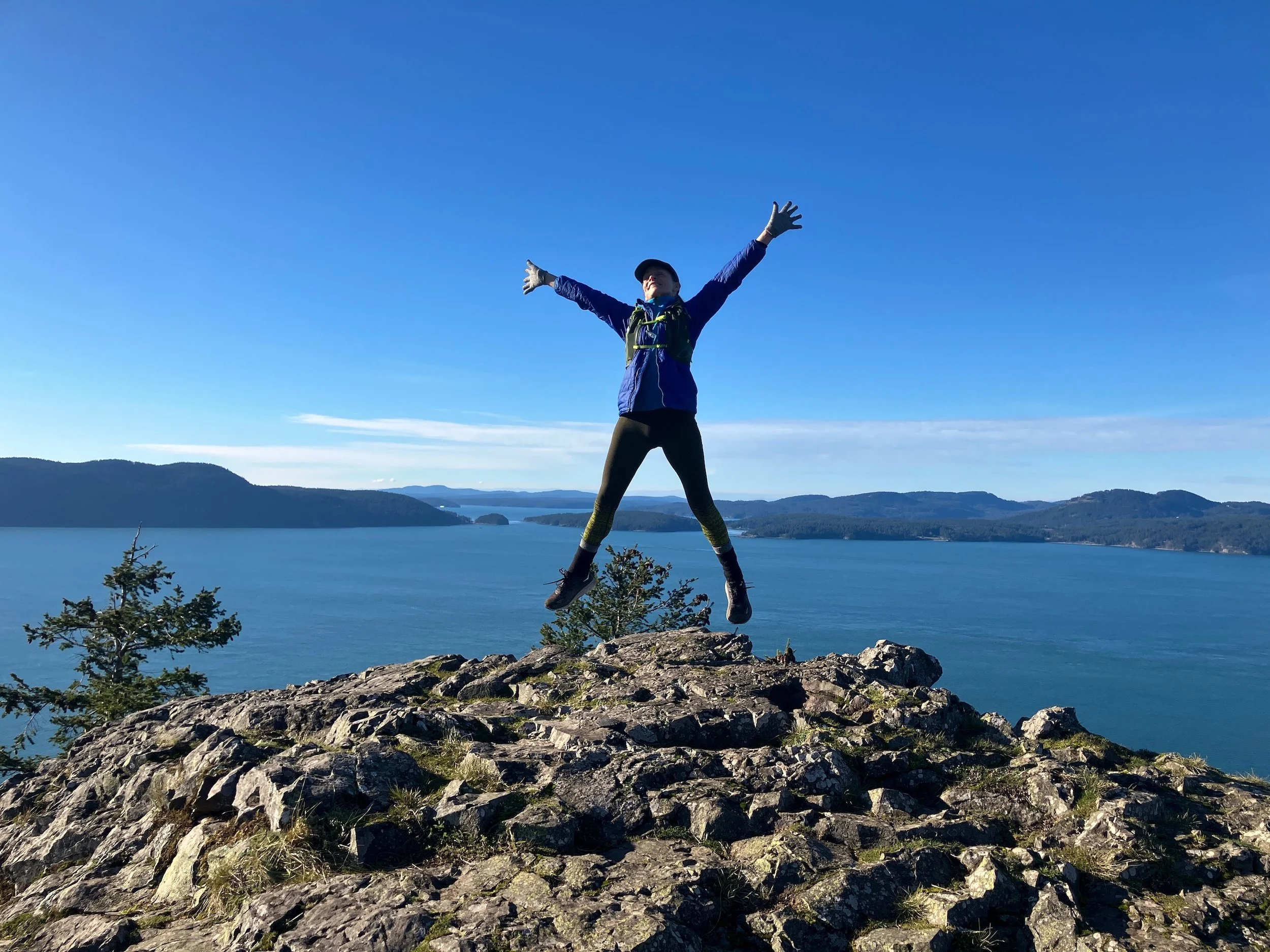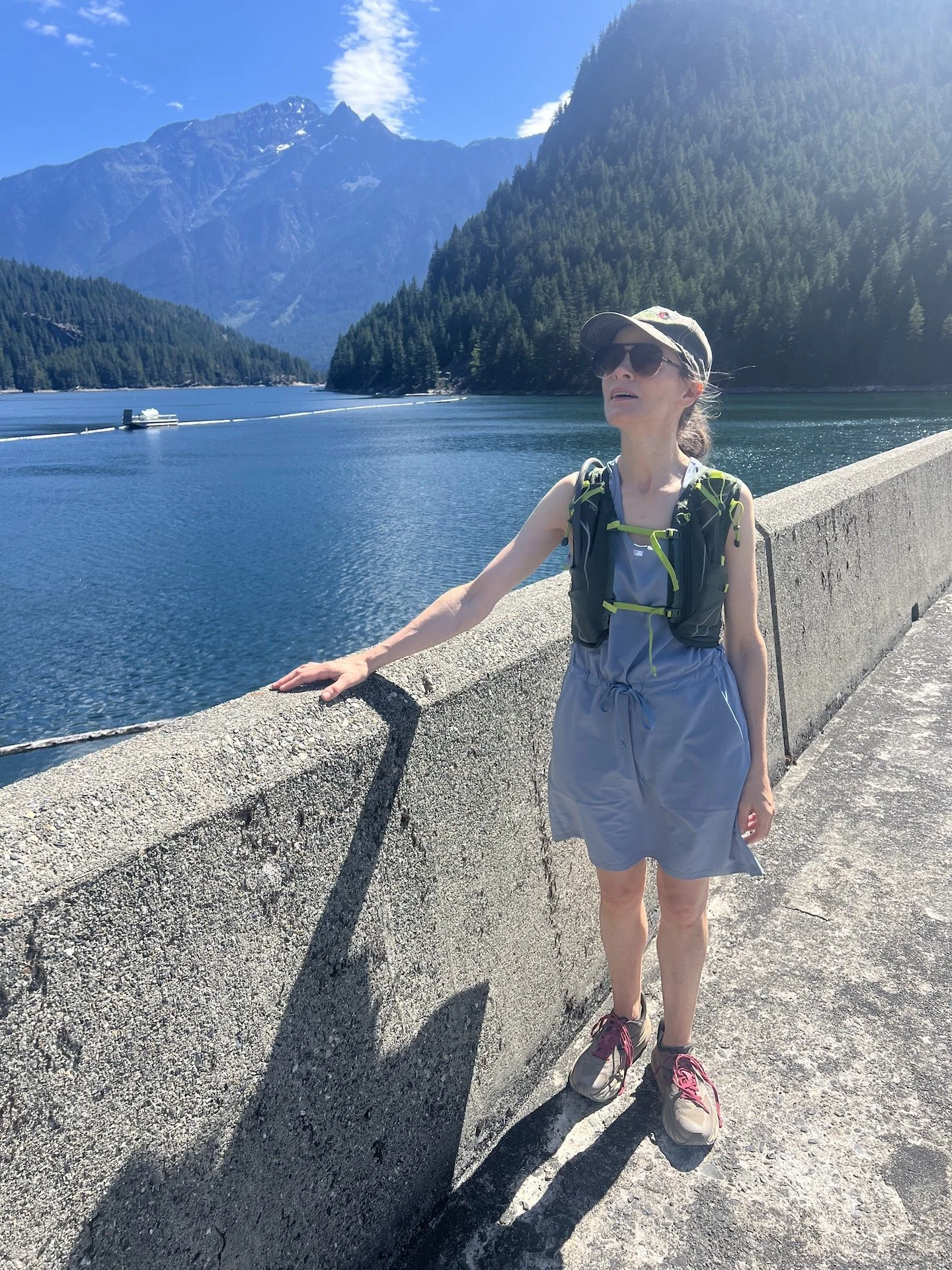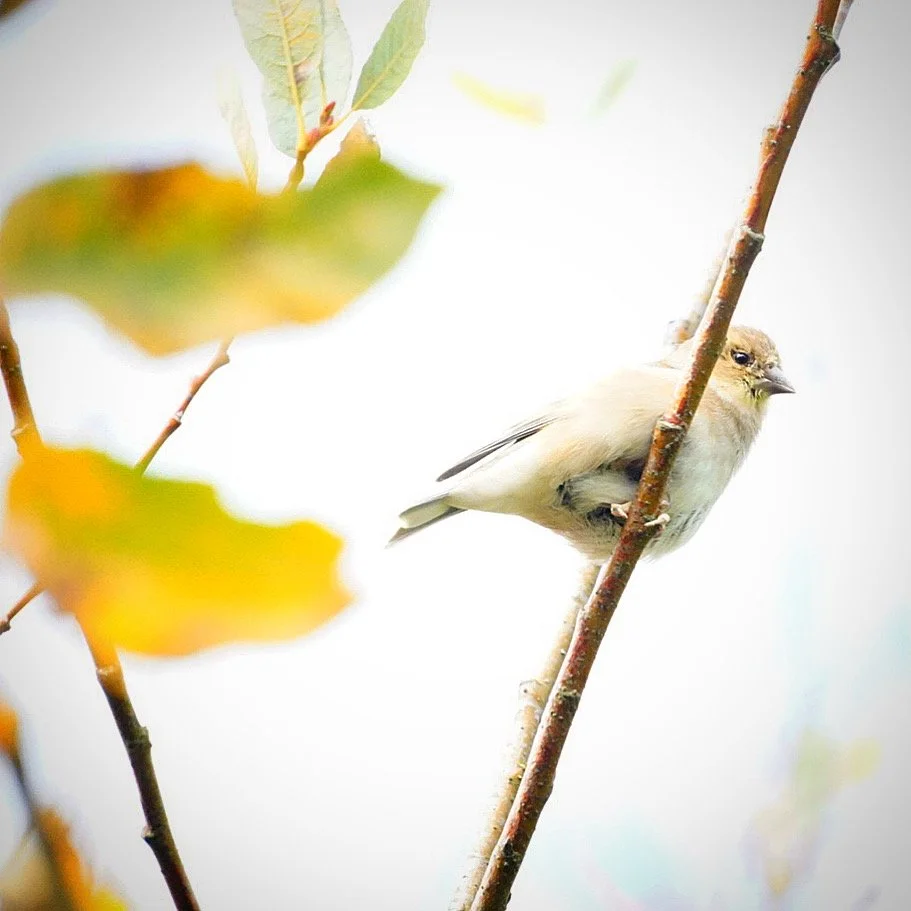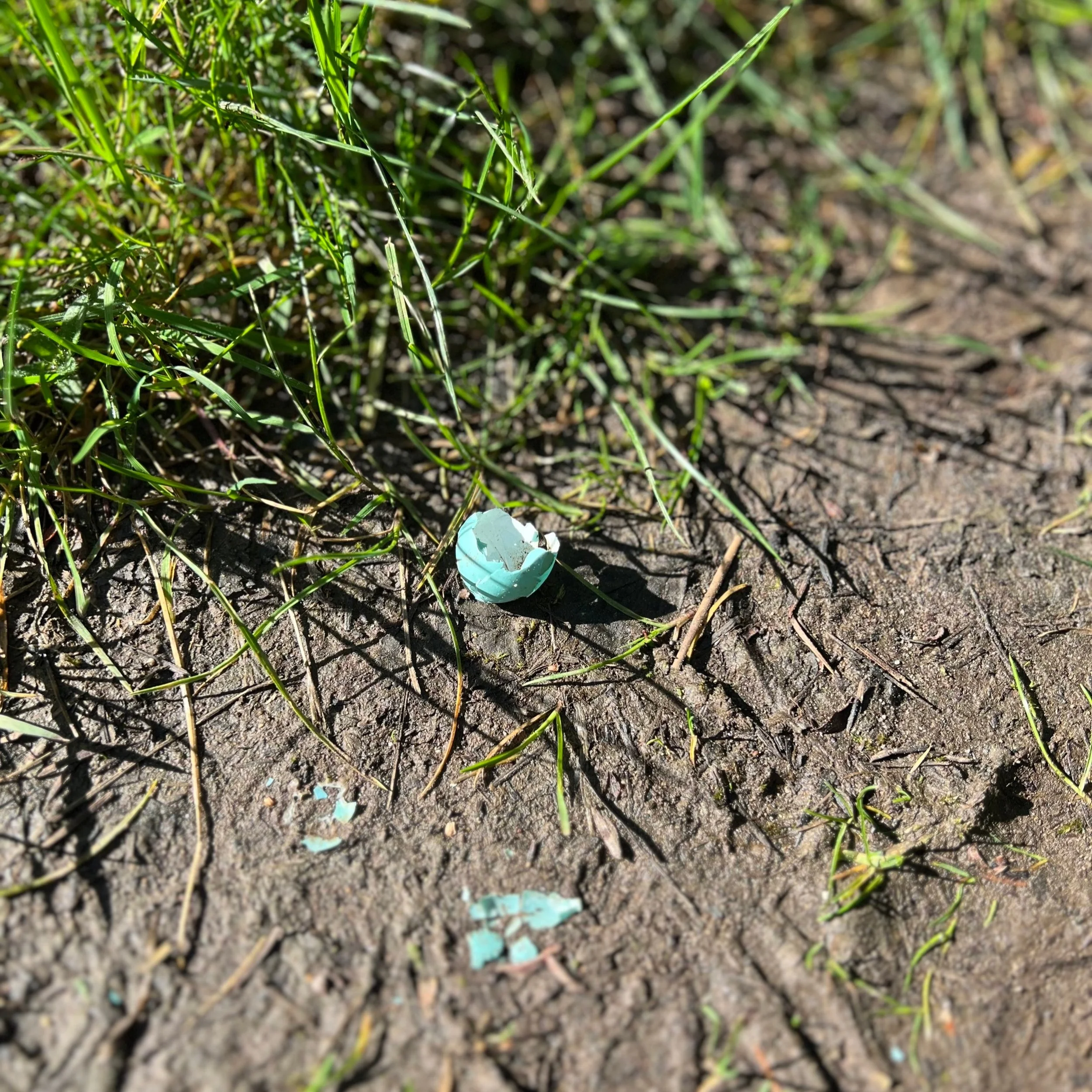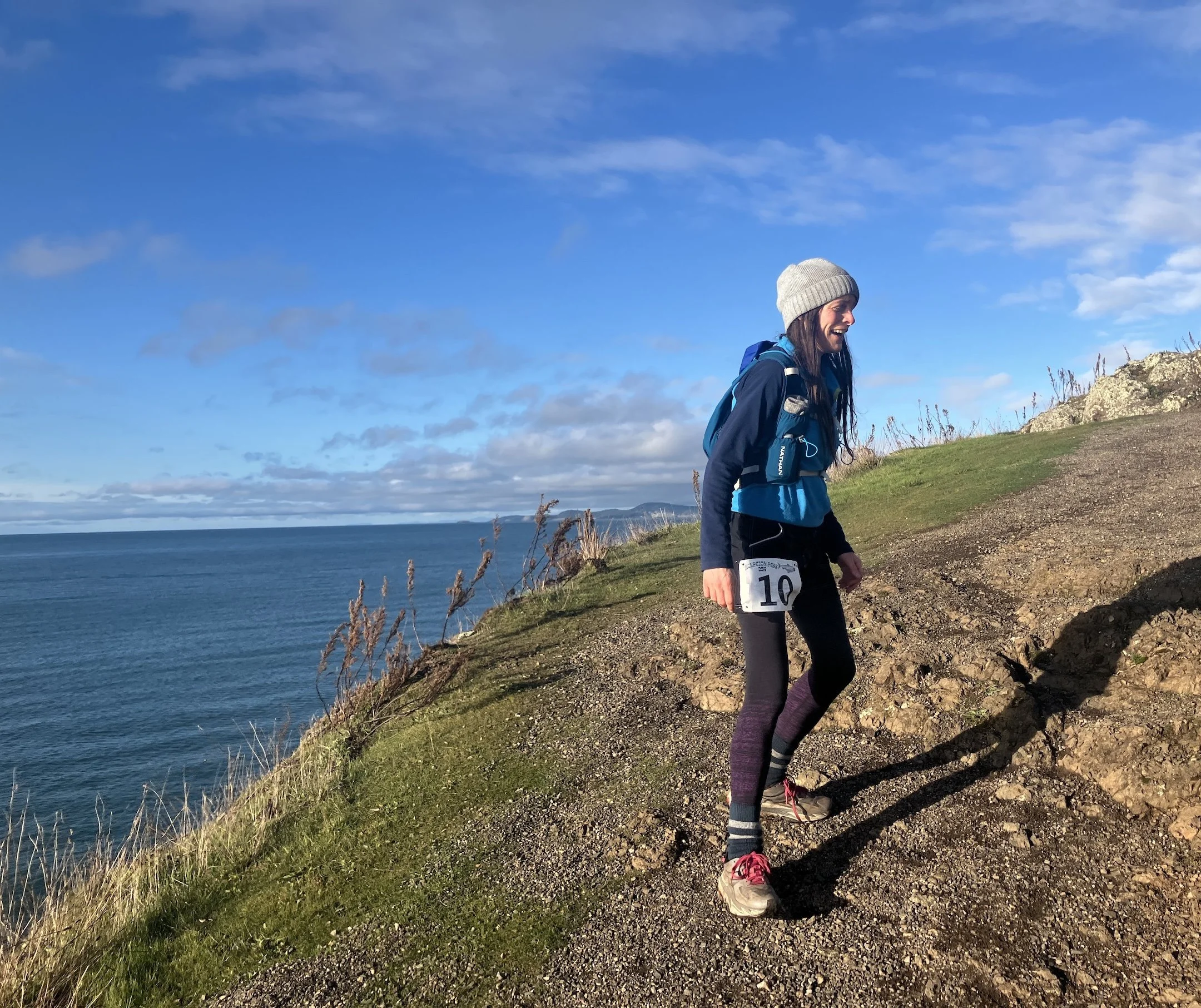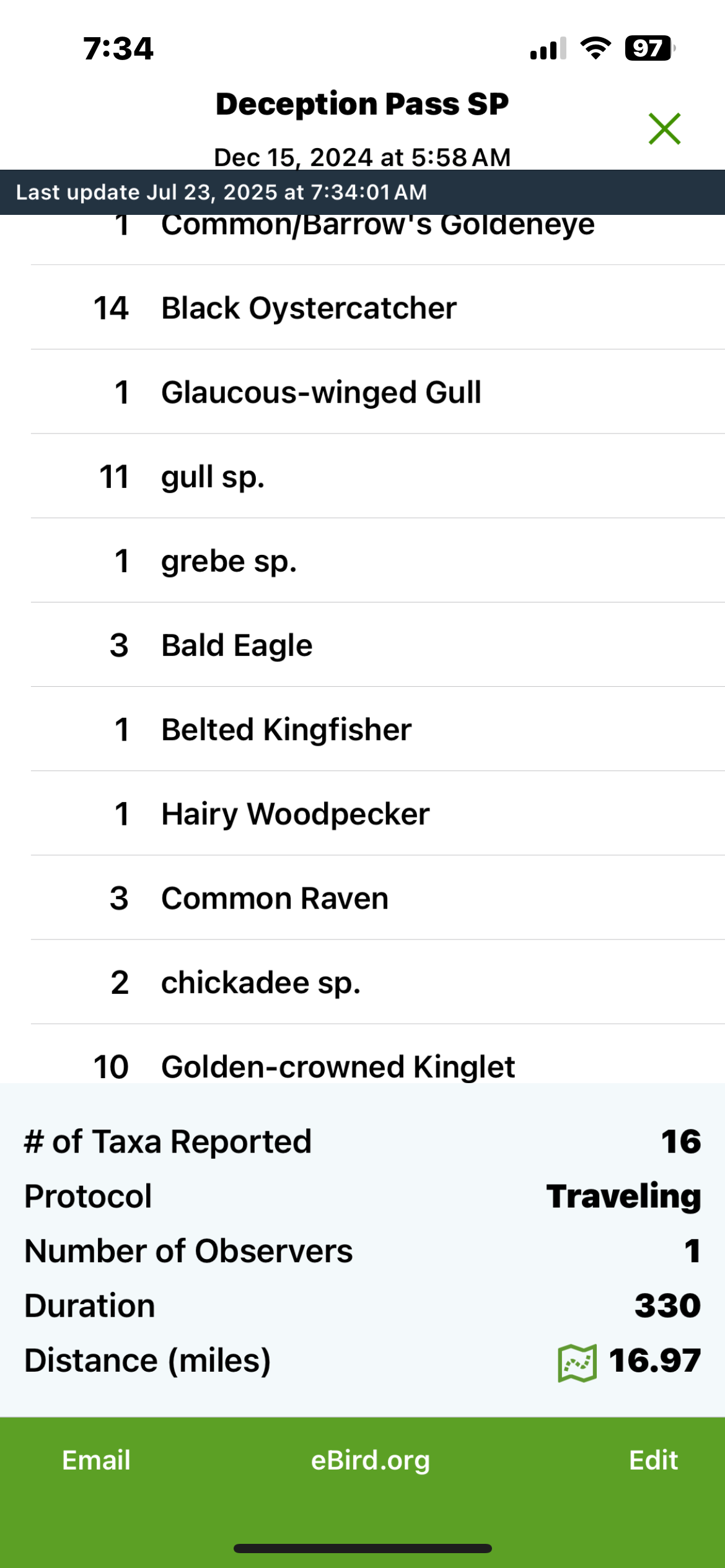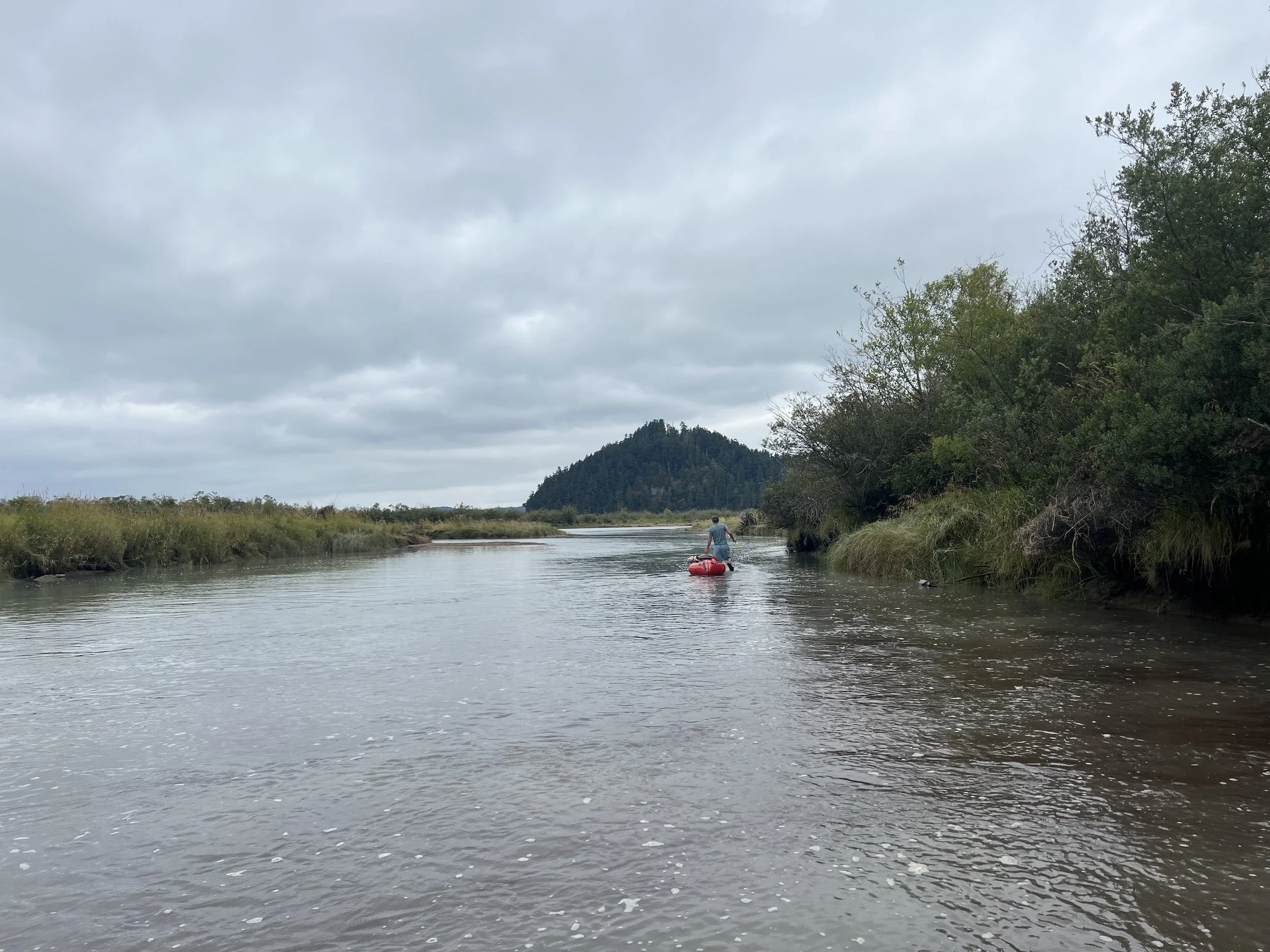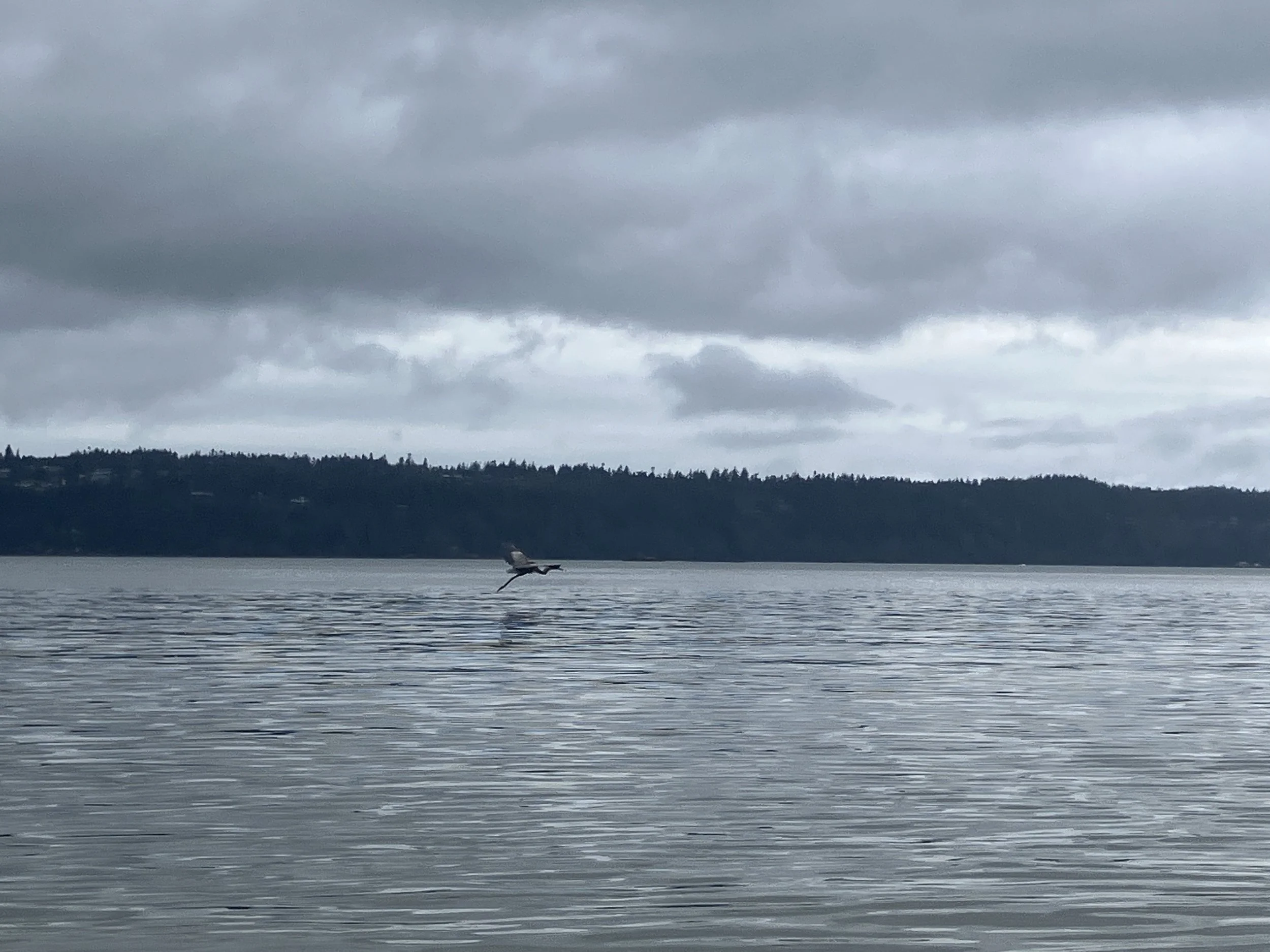Foraging, hiking, trail running, skiing, biking, paddling; what outdoor pursuit can you do and NOT also be birding? Outdoor recreation is whatever you choose to do outside (the list I provide here is just what I do, while also birding).
For those of us lucky to use our bodies to power ourselves through time and space with only nature as our potential constraint, nature is also our companion. I make sure to notice nature and its features as I am passing through. For me, it’s birds along the way.
Outdoor recreation is also big business. I’ve tried (so far unsuccessfully) to break into legacy media with the idea that birding is the missing “extra” to what has become an industry of outdoor recreation. If not its own category outright, at least you can roll birding into what you are doing already, right? So far, the closest I’ve gotten to crossover of outdoor adventure and birding was this piece for Washington Outdoor Women, an educational organization of women training other women for outdoor skills.
Thankfully, birding media takes my ideas, and well, runs with them like this 2018 story about birders who are also runners, for Audubon.org. Birding by bike also features in this story I did for Birding Magazine in 2024. These published stories are about other birders doing the thing. Now, I am joining them!
Combining outdoor recreation and birding
This post has two purposes: First, to give you ideas for how to roll birding into whatever you do outdoors, and maybe provide a few resources.
The second purpose is to share how rich it is to do this stuff if you’re able. I’m not getting any younger, and I only have one life. Why did I wait so long to start so many of these activities? I enjoy outdoor recreation for pleasure, not competition. The same as I enjoy birding. I write this with the full understanding that outdoor recreation can become a chest-thumping exercise of one-upping, especially here on the internet. I hope that is not what you take away from reading this.
Paddling is a great way to access habitats otherwise inaccessible, like tidal sloughs, which are often too muddy and marshy for a trail system, and too tidal and shallow for boats with a draft. This water under me was only about 6 inches deep. Skagit River Delta. August 2025. Photo by Seth Wolpin.
The last few years I’ve added more pursuits to my own outdoor repertoire, and documented my time accordingly (while also birding). Learning how to do most of these things whether birding or whatever else, involves other people. You’ll see me reference other people in this post, and that’s because outdoor recreation doesn’t happen in a vacuum. Every person posting about their adventures learned from someone else, myself included. And lucky me, more often than not, I had company in the examples I share here.
Friends serve as my companions, mentors and on one occasion, my life saver! Some of this outdoor stuff is tricky to do solo, never mind something to casually combine with birding. Some activities should be primary, the birding necessarily secondary.
Mishaps can happen! I was thankfully in good company when I had my own near miss during one of these outings. Ever see that bumper sticker “Will Swerve for Birds”? Yeh, this wasn’t exactly swerving, more like dunking. Totally my fault. Sometimes you gotta do the thing, not the thing AND birding (you’ll read below what happened).
Watching Peregrine falcons above Ross Dam while hiking at Ross Lake in the North Cascades National Park, Washington State. July 2025. Photo by Gilia Angell.
I’ve organized the activities here with increasing pace of distance covered (and a final jump into watercraft). I hear over and over the advantage of running or biking while birding, for instance: You cover so much more ground for seeing birds!
Method and tools: Most but not all of my adventures in outdoor recreation and birding were done birding by ear, and without accessory optics. I found carrying binoculars, even small ones, cumbersome for the payoff. I am content to hear birdsong (and occasionally rely on the Merlin app to confirm my hunch for what I am hearing), and catch glimpes of birds with the naked eye. I track what I see and hear about half the time on eBird, more often when I am in the company of other birders versus when I am alone or doing something especially active.
Moving through a landscape at your own power is not an excuse to flush or disturb the wildlife. I follow the American Birding Association’s Code of Birding Ethics, always, no matter if I am running or standing still.
I will say this again, too: If you have access, skill, inclination for outdoor recreation, share those assets with others. Everything I’ve experienced in my recreational life is the result of someone else showing me the ropes. If you occupy a space of such skill and knowledge, think of someone whose company you enjoy who might also be curious to join you, and invite them!
Foraging
Imagine scouring the forest floor for fall mushrooms while listening for birdsong in the canopy above. Talk about an elevated sensory experience! With food at the end! When birder friend Kim Roth Nelson mentioned her autumn foraging adventures in the same woods where we’ve birded together (plus a few secret locations she has no obligation to share with me) I wanted to look for chanterelles, too.
My boyfriend Seth and I set out foraging as additive to our trail running, more curious than mercenary (and tertiary, as I was already birding when we added mushroom-hunting to our runs). Soon, foraging became a reckless distraction as I scanned the greater woods for pops of orange under conifers instead of watching the trail ahead of me. My lower-canopy scanning for fungi produced sights of birds too, like Pacific wrens, Dark-eyed juncos and Song sparrows.
Dark-eyed junco. Photo by Roniq Bartanen.
Luckily no twisted ankles in our efforts, and often a meal’s worth of mushrooms packed into our running vests.
We learned foraging from others, much like one learns about birding from more seasoned birders. On one of our first outings as baby foragers, we met a young couple Rachel and Jeremy, coming opposite of us on the trail, their baskets brimming with mushrooms from a morning of foraging. Their eyes twinkled as they saw our eyes widen at their haul.
Rachel and Jeremy are mushrooming enthusiasts, ready with how-tos and tips. They gave us a real time tutorial identifying in the hand—from their stash—and were the ones to suggest we selectively forage for certain varieties and leave the rest for the squirrels and bugs (some mushrooms like boletes, though culinary, are maggoty).
Their advice to discern served us well since we carry only what will fit in our running vests. We also carry a pocket knife, and a mushroom guide. This guide book is a classic: All that the Rain Promises, and More.
Seth gallantly carrying our chanterelle haul. Foraged in San Juan County, WA. November 2024.
Hiking
Hiking is already what we birders do when perusing footpaths for bird sightings. When birder friend Katie Barnes came through Seattle one summer, I suggested a hike to Mount Rainier as our meet up, to show her an iconic landscape during her stay, and do something outdoorsy that we both enjoy (Katie is coincidentally one of the birders featured in the aforementioned Audubon run-birding story).
Katie Barnes lingering in the woods along the Grand Park hike at Mount Rainier National Park, WA. August 2023.
That day in August was fruitful for both grand scenery (the hike is called Grand Park, aptly named) and memorable bird sightings. We ascended from woods into alpine meadows, surprising a group of ravens feasting on the grasshoppers erupting from the ground cover. The ravens disbanded at our appearance, settling in the trees nearby, then returning to the ground once we passed.
The grasshoppers were everywhere in the meadow. They leapt from the path like parting waves as we made our way toward the view of the mountain. Mid-morning heat and still air hung around us, oppressive to our physical progress but helpful for hearing birdsong and catching sight of movement.
As a resident of Louisiana who grew up in Pennsylvania, Katie was eager to see some West Coast mountain species, in particular a Clark’s Nutcracker, and maybe an American Three-toed Woodpecker, the latter which I’d seen for the time on this same hike a decade earlier. There’s pride of place when showing a visitor a birding spot, a hope that our time together might be made all the more memorable with a lifer sighting. Many a birder host knows this feeling!
Katie at the very moment she spotted her first Clark’s Nutcracker. Mount Rainier National Park, WA. August 2023.
Happily, Katie got her Clark’s Nutcracker, all on her own! I also saw a lifer that day (according to my eBird), a Townsend’s Solitaire (we never did see a Three-toed Woodpecker, alas). But really, these photos, how could you forget a hike like this? These bird memories made it that much extra.
Here we are with the mountain behind us! Me and Katie Barnes at Mount Rainier, July 2023.
Birder buddies Roniq Bartanen and Wendy Walker shutter-bugging the wildflowers at Iceberg Point, Lopez Island, WA. May 2024.
Sometimes hiking starts out including birding and further rolls in the whole ecosystem. If you have ever been on one of Roniq Bartanen’s bird outings, you know she sees everything in the landscape.
I joined Roniq and our friend Wendy Walker for a visit to Lopez Island in Washington’s San Juan archipelago during the May wildflower display. We three know each other from the days when Birds Connect Seattle was known as Seattle Audubon. Wendy worked there and Ro and I were both volunteers (Ro still volunteers for the organization as a birding guide).
On the trip depicted in these photos, Roniq and Wendy are photographing the variety of wildflowers along the trail at Iceberg Point, a display that nearly sidelined the birding that morning! Not complaining, the flowers were beautiful!
Chocolate Lily at Iceberg Point, Lopez Island, WA. May 2024.
Me photographing Wendy photographing wildflowers, Iceberg Point, Lopez Island, WA. May 2024.
American Goldfinch. We saw 10 of these cuties on that walk at Iceberg Point in May, 2024. This photo of an American Goldfinch was taken some months later that same year elsewhere in Western Washington. Photo by Roniq Bartanen.
More silhouettes! Wendy, Roniq and me in the middle, this time identifiably birding (see the outlines of the binoculars?). Lopez Island, May 2024.
Trail running
Now we’re picking up the pace moving through a landscape! While trail running has me looking at my foot fall more than when I walk or hike, the advantage is I notice things like this broken Robin’s egg, or a single feather, or an owl pellet, or the remains of a kill (either of or by an avian resident of the given woods). I hear birdsong change through the seasons of my running route, and I cover more ground in less time than I do on a walk or hike. I’ve run since age 11, when my sister Gilia and I discovered cross country running. I’ve kept it up into middle age, off and on.
American Robin eggshell, Cypress Island, WA. April 2024.
Running the trails at Kiket Island, Skagit County, August 2024. Hoping to catch sight of the Red Crossbills I heard overhead. Photo by Seth Wolpin.
Much of the running I do these days is with my boyfriend, Seth. His adventure CV is impressive: he has his own account of almost two decades of adventures, including trail running in landscapes from Nepal to Kenya to our local Cascade Mountains, and he co-led a fast-packing (self-supported run-trekking) tour company in Nepal for 10 years.
These days we run local trails where we live. For fun, we signed up for an organized 25K race (about 16 miles) at Deception Pass State Park near where we live. This would be my first time running that distance, let alone my first organized race. I’d already been birding while we ran together, and I thought, why not eBird this race? Had anyone eBirded while running the Deception Pass 25K before? What other runners eBird in races?
I shared my idea with my birding friends, to hold me accountable for actually doing it. Wendy suggested I voice memo while running, as I would not want to stop during the race to jot notes on my phone. I would log the eBird list for the duration of the race, and count only the birds I could confidently identify by ear and sight (the latter without optics).
Pre-race, checking out the dozen Black Oystercatchers on the rock right offshore of the parking lot at Deception Pass State Park. It’s the one moment I used binoculars during my eBird race count. The time spent running was without additional optics. December 2024. Photo by Seth Wolpin.
Me mid-course, laughing at the absurdity of trying to eBird while running a 25K. December 2024. Photo by Seth Wolpin.
EBirding while running an organized race of almost 300 people on forest trails is, well, kind of a stunt. Right away the leading runners flushed all the birds on the trail. By the time runners like us in the middle of the pack passed through, the course was quiet at ground level. The list below doesn’t include all 16 species from the count (the screenshot is cut off); most birds were upper canopy (heard only) or fly overs. I saw very few in the end.
The eBird list from the morning of the Deception Pass 25K race (including the pre-race oystercatchers). Sixteen bird species counted! Mostly heard, tallied by voice memo, and reported after the race ended.
Since eBirding while running that race, I’ve gathered testimony from other birder runners for a forthcoming story about run birding, for a national membership birding magazine. Yes, a second published story about run-birding, because the world needs it, right?
And that question from earlier—have other runners reported eBird checklists from organized races? I still don’t know. None of the folks I interviewed for the forthcoming commissioned story above have done so, yet. I may ask the race organizers of Rainshadow Running, the company which hosts the Deception Pass races. Stay tuned for that tidbit.
With Seth Wolpin, my partner in many of the outdoor recreation and birding adventures depicted here. On Mt. Erie in Skagit County, WA. April 2024.
Alpine Skiing
Yes, it’s possible to bird while alpine skiing! My friend Georgia Silvana Seamans is my inspiration and is the first person in my observation to write about the unexpected birding opportunity of a ski vacation, in her case to Colorado, a distinct change from New York City where she lives. It so happened that two common birds of the Rocky Mountain location (Mountain Chickadee and Pine siskin) were lifers for her as a New York City resident and East Coast birder.
I take my cue from Georgia’s story, and treat birding as additive to this activity which otherwise requires my full attention. I learned to alpine ski as an adult in 2024, and have only ever skied in my home state of Washington, at the Mount Baker Ski Area. My attention is on the slope ahead and not as much to the sound or sight of what birds might be present in the surrounding mountains. But birds are present! Well, a single species: The Common Raven. Spotted in the sky (a real bird) and at the entrance to the ski area (real in bronze, anyway) as you can see from the photo below.
Raven sculpture by Tony Angell (yes, my dad!) at the Mount Baker Ski Area playfully adorned for Easter Weekend, April, 2024.
Common Raven. Photo by Roniq Bartanen.
Skiing slow enough as a novice to hear the occasional Common Raven from the green runs on the slopes of the Mount Baker Ski Area, April, 2024. Photo by Seth Wolpin.
Like Georgia, I think there is potential to bird in ski areas. Probably better birding away from the resort, or cross-country skiing or snow-shoeing. Winter recreation has promise for keeping up the birding habit!
Biking
Next up for passing through a landscape and making greater progress in less time is biking. Seth and I recently bike-packed (biking and camping) along the 27-mile White Horse rails-to-trails path in Snohomish county, Washington state. Neither of us is comfortable road-biking any distance, so we stick to these railroad-grade trails suitable for bikes and walkers, and off-limits to motorized vehicles.
I have to mention that the biking on these trails—though flat and without the stress of car traffic—is still hard-going. The trails can be washed out, muddy, graded in gravel that’s like biking through loose sand (except it might puncture your tire), and even when you cycle over the few paved portions, there may be blackberry tendrils from the shoulder reaching to snag your legs and arms.
The lack of significant upkeep to the trail does make for great birding by bike, however. We saw Spotted sandpiper along the Stillaguamish River, heard Swainson’s thrush in the canopy, and even met some other birders (walking). We stopped and asked what they were looking for (Western wood-pewee), before continuing on.
Biking the White Horse Trail, a 27 mile rails-to-trails bike and hiking path in the North Cascade foothills of Washington State. If you look closely, you can see how large the gravel substrate is in this section of the trail. NOT good for biking (I was churning my wheels up ahead, vs cycling). July 2025. Photo by Seth Wolpin.
The highlight of the birding (made possible by our biking) came that night, when we were cozily tucked into our tent after we made camp, off-trail (we stealth camped; there are no campgrounds on the White Horse trail). A shrill vocalizing woke me up around 4am, an intermittent, single shriek resonant of a squawk from a parrot species, trying to get the attention of an assumed family member. A determined bird, saying “Over here!” The bird I heard was confident enough to vocalize at night; it wasn’t concerned about becoming someone’s dinner for the attention it drew to itself. Sure enough, the Merlin app identified it as a Great-horned owl, a youngster begging.
It continued shrieking for minutes, the show-stopping moment arriving when its shriek was interrupted by what can only be described as owl gurgling, as its parent delivered something to eat.
Astonishingly, Seth slept through the baby owl audio show, but later than morning the owl picked up again, this time in the light of dawn, and accompanied by mobbing Stellar’s jays and American robins. We never did see the bird (we did not look for it, only listened to the show) and it eventually quieted. As we broke camp and returned to the trail, we discovered what was probably its roosting tree, for the guano-spattered ferns below it.
Evidence of a Great Horned owl near our campsite. White Horse Trail, WA, July 2025.
The vine maple tree above the guano-speckled ferns. Owl’s perch! July 2025.
Seth bringing the bikes back to the trail from our primitive campsite. That’s the same owl tree right behind him! July 2025.
Paddling
Now we head to the water for traversing. Paddling (kayaking, canoeing, pack-rafting) is something I picked up recently, thanks to Seth, whose curiosity for outdoor recreation is seconded by his generosity to share the fun with his friends, and thirded by his objective to make these adventures happen. We live in a land of rivers, lakes and the inland salt waters of the Salish Sea, where even if the land itself is privately owned and inaccessible, the waterways are public space. Hopping in a kayak gave me previously unimagined potential for birding from a new vantage.
That said, birding from a single human-powered water craft is not easy birding. A body of water and its currents, depth, temperature and contents are formidable companions of a paddler, not to be ignored for a sudden distraction of a bird. I learned this lesson the hard way.
While paddling the Skagit River between the towns of Rockport and Concrete, we enountered mostly slow-moving waters. Being late spring, though, the water was high, and we were aware of logs both above and beneath the surface, especially when we paddled closer to the riverbank.
All smiles in front of Mount Baker, on the Skagit River near Concrete, WA, right before I capsized while birding. Whoops. June 2024. Photo by Seth Wolpin.
Seth recalled seeing swallows flying in swarms along a certain stretch of the river from a few years earlier, and I suspected possible nesting in the banks. In the photo above, it’s those banks behind me where I thought I might see bird activity.
While peering for evidence of nests in the bank, I was surprised by how quickly I came upon a group of logs, and miscalculated my timing for avoiding them. I did not avoid them; I met them, in the water.
I narrated my own capsizing to Seth who was ahead of me, as I knew I couldn’t prevent it. Thankfully I was wearing a wetsuit, and had mind to anticipate how I would swim to shore once I was out of the boat. Seth fetched the boat and floating contents and quickly paddled back to me, just minutes in passing. By then I was perched on a steep bank, no place to try to dry off, so I had to pile back in my boat and follow Seth to a safer shoreline. There I changed into Seth’s dry clothes and shivered for an hour, jumping around and trading hugs with him to warm up. I had never been so deeply cold from just a few minutes in that cold river water, and the cold lingered uncomfortably long.
Post-capsizing, entirely dressed in Seth’s spare clothes, recovering from near-hypothermia. Still smiling (through chattering teeth)! June 2024. Photo by Seth Wolpin.
We reviewed our course and how a slow moving river can still be treacherous with hazards like those logs. If I had to capsize, well, it happens to most paddlers, and we learn what NOT to do from it, my lesson pretty specific: don’t try to bird and paddle a river at the same time!
And paddle in company! To say I was grateful for Seth’s quick actions and caretaking is putting it mildly: I credit him for keeping me from falling into dangerous hypothermia that day. When your body is in shock, you need the care of someone else to manage you through it. This experience would be the first time I would blame birding for a mishap. May this lesson assure that I am more selective about which activity I prioritize if combining outdoor recreation and birding. Sometimes one at a time!
That’s Seth wading in the shallow water of a slough in the Skagit River estuary. At points on this paddle it was easier to wade, given the shallow water and strong current as the tide came in. Two hours later at high tide the water was several feet higher, and placid. August 2025.
Thankfully I am back in the boat! Exploring by water craft is simply too alluring for things I would never see otherwise. Paddling other parts of the Skagit River closer to its estuary with the Salish Sea, we are beholden to tides. We see birds like a Great Blue Heron as it forages in waters six inches deep and we float by at its same level in our kayaks. We might paddle a stretch of water that looks endless and two hours later it is mud flats that would be impossible to traipse on foot.
Great Blue Heron flying over water that’s barely a foot deep. We were in sea kayaks, the undersides of our crafts grazing the mud flats below the surface. That heron had been standing in the water a moment before. Skagit Bay, WA. September 2024.
And I end my post here with an image of another swallow nesting site, this time firmly confirmed with visible nests (albeit vacant, as this was July and they were already fledged and departed). We had the pleasure of lingering in the water below this colony, marveling at its architectural structure and imagining coming back to see the birds the following year (I didn’t make it yet, darn).
Vacant Cliff swallow colony near La Conner, WA. July 2024. Birds already flown south.
So there you have it, some examples of outdoor recreation and birding, some of it justifiably borderline but all of it ultimately satisfying and yet another way to elevate whatever you are doing. May the highlights and hazards presented be instructive for you. I would love to hear about others combining birding and their favorite outdoor recreation. Share your stories in the comments!
